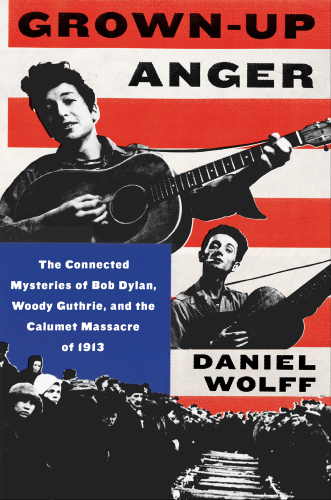
Grown-Up Anger
The Connected Mysteries of Bob Dylan, Woody Guthrie, and the Calumet Massacre of 1913 T
کتاب های مرتبط
- اطلاعات
- نقد و بررسی
- دیدگاه کاربران
نقد و بررسی

April 24, 2017
In this bold and moving history, author and songwriter Wolff follows a path of memory and resistance through the labor struggles and music of 20th-century America. Wolff argues here that the mass murder of 74 men, women, and children (mine workers and members of their families—most of the victims were children) during a bitter strike in 1913 in Michigan reverberated through the careers of two remarkable American musicians. Using Woody Guthrie’s elegy for the massacre as a launching point, Wolff examines how the dust bowl and the Depression transformed the hillbilly entertainer into a radical artist. Linked to Calumet through his own Midwestern origins and his wholesale imitation of Guthrie, the young Bob Dylan inherited his role model’s hobo crown. Yet the very different conditions of post-WWII prosperity and teen rebellion in which he came up led Dylan to reject the pious expectations of the folk scene for a more personal rebellion, one that remade rock and roll. Without surrendering insight or authority, Wolff spans a remarkable range of material, including 19th-century copper mining on the Upper Peninsula, the origins of folk out of traditional genres, and the ’60s counterculture. Wolff’s descriptions of Guthrie are particularly engaging, as are his forays into music criticism and labor history. At times, the anger that Wolff foregrounds appears too amorphous to convincingly unify such diverse subjects and eras. Yet in a scathing finale that sends him to the postindustrial ghost town of Calumet, Wolff makes clear that by forgetting the past that Dylan and Guthrie passed down to us—and the injustices that motivated their art—we are in danger of losing our futures.

Starred review from April 15, 2017
A masterful tale of music, social, and economic history.In 1965, when poet and essayist Wolff (The Names of Birds, 2015, etc.) was 13, he first heard Bob Dylan's "sound of anger" on the radio. "Like a Rolling Stone" impressed him mightily. He sought out his earlier albums, and on Dylan's first, there were two original songs. One was "Song to Woody," which was "the sound of someone looking back in order to tell the truth." This led the author to find out more about Woody Guthrie and to hear his music. He discovered a great singer/songwriter and political activist. That search then led him to Arlo Guthrie and his album, "Hobo's Lullaby," which included one of his father's songs, "1913 Massacre." In Calumet, Michigan, mostly striking mine workers, their wives, and children were having a crowded Christmas party in a large hall when someone falsely yelled "Fire!" In the desperate crush to escape, 73 people died. Listening to the song, Wolff realized Dylan had used the very same melody for his song about Guthrie. The pieces were falling into place: "Follow that darkish vein back to find...what? The history of anger. Hope. The truth." The author takes us on a stunning, riveting journey as we learn about the young Dylan, Woody, Joe Hill, the famous singer/songwriter and union leader, the small town of Calumet, with its copper-mining operations in Michigan's Upper Peninsula, and the unions and miners who were constantly taken advantage of by management and the mine owners. Along the way, Wolff introduces us to Woody's fellow activist musician Pete Seeger and noted song collector Alan Lomax. He also tells the story of union organizer Ella Reeve "Mother" Bloor, who first told Woody the Calumet story, and Alexander Agassiz, son of the famous scientist, who hired James MacNaughton as the union-busting manager of the Calumet mine in 1901. Wolff's elegantly intertwined historical drama is consistently revelatory. A dazzling, richly researched story impeccably told.
COPYRIGHT(2017) Kirkus Reviews, ALL RIGHTS RESERVED.

April 1, 2017
On Christmas Eve, 1913, 73 people (mostly children) were killed in a stampede at a Christmas party in Calumet, MI. This tragedy, related to a bitter copper miners' strike, was commemorated in Woody Guthrie's 1945 song "1913 Massacre," and is at the core of this book. Wolff (4th of July, Asbury Park; You Send Me: The Life and Times of Sam Cooke) weaves Calumet and early labor strife into a dual biography of Guthrie (1912-67) and Bob Dylan (b. 1941). It alternates chapters relating Guthrie's and Dylan's formative years, emphasizing how injustice and older folk and blues music influenced their songs. His chapter on the stampede, its aftermath, and Guthrie's song, is very effective and moving. Two personal essays bookend this work. In the first chapter, Wolff writes about his discovery of Dylan as a high school student and the profound impact of "Like a Rolling Stone." He concludes with an almost Orwellian account of a 2013 visit to Calumet, where he visited the cemeteries and saw the remains of a once-thriving mining town. VERDICT Readers with an interest in American political and labor history will most appreciate this book. Fans of Dylan and Guthrie will be in familiar territory but will also learn about strands of influence on their work.--Thomas Karel, Franklin & Marshall Coll. Lib., Lancaster, PA
Copyright 2017 Library Journal, LLC Used with permission.

























دیدگاه کاربران